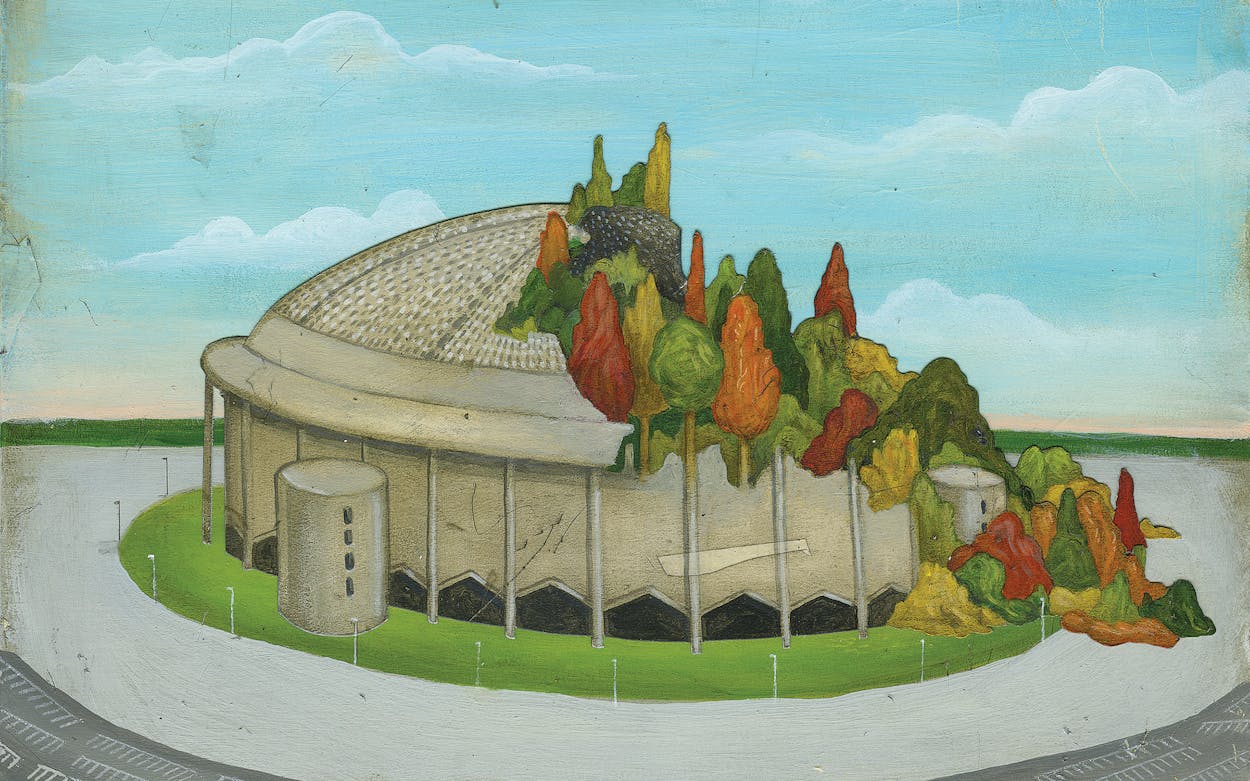Five years ago, a nonprofit called the Astrodome Conservancy announced that Houston’s most iconic building, shuttered for more than a decade, would reopen to the public for one evening. The 25,000 free tickets were claimed in less than two hours. Local sports fans did whatever they could to get a final glimpse of the famous stadium before a planned $105 million renovation that would transform the Dome into an event space and parking garage.
Dressed in vintage Astros and Oilers jerseys, the visitors shuffled reverently down a loading ramp and onto a vast concrete expanse that was once the playing field. The actual field, acres and acres of synthetic Astroturf, had been cut into sections, rolled up like carpets, and stacked in what had been the outfield. The stands were bare—most of the rainbow-colored seats had been ripped out and sold as souvenirs—but a billboard for the now defunct Continental Airlines still presided above the outfield.
It was a sad end to a building that had dazzled the world when it opened in 1965 with a sold-out exhibition game between the Astros and the New York Yankees. The Astrodome debuted in a shower of superlatives: the first indoor baseball stadium, the largest interior space on earth, the Eighth Wonder of the World. Roy Hofheinz, the flamboyant politician turned businessman who dreamed up the venue and oversaw its construction, claimed he had been inspired by the Roman Colosseum. Hofheinz lived for many years in an opulent five-story apartment overlooking right field. A booklet published to commemorate the Astrodome’s grand opening featured a suitably grandiose epigraph from Samuel Taylor Coleridge: “In Xanadu did Kubla Khan / A stately pleasure-dome decree . . .”
Flush with oil wealth, Houston in the sixties was among America’s fastest-growing cities. With NASA’s manned space program headquartered just down the Gulf Freeway in Clear Lake, civic boosters adopted the moniker “Space City”; the Houston Colt .45s changed their name to the Astros. In a city still emerging from Jim Crow, the Astrodome would be fully integrated. Hofheinz, who as Houston mayor in the fifties had desegregated public golf courses, buses, and libraries, now encouraged efforts to end segregation in the city’s hotels and restaurants as well, so that visiting teams could stay and eat together.
Perhaps no building has ever changed a city’s image so dramatically. Prior to the Astrodome, many Americans viewed Houston as racist, backward, and physically ugly. Now these same Americans flocked there to admire an architectural marvel. As late as 1974 the stadium was the country’s third-most-popular man-made tourist attraction, after the Golden Gate Bridge and Mount Rushmore. Not everyone loved the Dome—Larry McMurtry groused that its silhouette looked like the “working end of a gigantic roll-on deodorant”—but the stadium embodied Houston’s belief that with enough money and chutzpah it could accomplish anything.
Anything, it would appear, except saving the Astrodome. By century’s end, the stadium was no longer unique—dozens of more lavish imitators had sprung up around the world. Astroturf, which had been speedily installed after it was discovered that grass would not grow in the Dome, had fallen out of favor, blamed for a rash of player injuries (and player rashes). Bud Adams, owner of the Houston Oilers, demanded that Harris County build a stand-alone football stadium; when he didn’t get one, he relocated the team to Tennessee in 1997. In 2000 the Astros decamped for Minute Maid Park, which featured a retractable roof and real grass. After hosting musical acts including Selena, who played her final concert there, the Dome ended its life as a concert venue in 2002 with a set by George Strait.
For the past two decades the Dome has squatted, silent and empty, in the literal shadow of NRG Stadium, the Brobdingnagian home of the Houston Texans and the site of two Super Bowls. After briefly serving as a shelter for Hurricane Katrina evacuees in 2005, the Dome has been closed to the public, save for the Astrodome Conservancy event. The plan to turn it into an event space never came to fruition. Over the years, there have been proposals to convert it into a luxury hotel, a movie studio, a convention center, and a city park. All died on the drawing board. The Astrodome, which once embodied Houston’s dynamism, has since come to represent civic paralysis.
And so the Astrodome remains in limbo: too expensive to renovate, too beloved to tear down. Today, the words that come to mind when surveying the once mighty Dome are those not of Coleridge but of another Romantic poet: “Nothing beside remains. Round the decay / Of that colossal Wreck, boundless and bare / The lone and level sands stretch far away.”
This article originally appeared in the February 2023 issue of Texas Monthly with the headline “The Eighth Blunder of the World.” Subscribe today.









